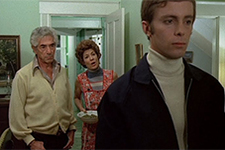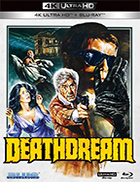Deathdream (4K UHD) [Blu-ray]
|  In the introduction of his book Shocking Representation: Historical Trauma, National Cinema, and the Modern Horror Film, film scholar Adam Lowenstein describes in detail the final scene in Bob Clark’s low-budget horror thriller Deathdream (aka Dead of Night, aka The Night Andy Came Home) to explain what he calls “an allegorical moment”—“a shocking collision of film, spectator, and history”—which is perhaps the perfect description of Clark’s film and why it retains its effectiveness so many years later. Purposefully intended by make-up effects artist-turned-screenwriter Alan Ormsby as a commentary on Vietnam, Deathdream evokes the horrors of war via the return from Southeast Asia of a young man who is no longer the same—literally. His condition is never explicitly named, but he returns as some kind of vampire, risen from the dead by the sheer willpower of his despondent mother and forced to subsist on the blood of others lest his physical body begin to decay into the lifeless corpse it really is. Ormsby’s debt to W.W. Jacobs’s 1902 short story “The Monkey’s Paw” is obvious enough, although he shifts the burden of horror away from the parental desire to return a child from the dead gone horribly macabre to the specter of the living deaths endured by so many veterans who were haunted by their experiences and returned home changed in ways they could not explain and their loved ones could not understand. Ormsby makes that change explicitly supernatural, although the behaviors he gives his living-dead protagonist—blank emotional distance, sudden shifts in mood, violent outbursts—look an awful lot like PTSD. Deathdream belies its low budget with both an impressive cast headed by veteran character actors and director Bob Clark’s creative economy, which he had displayed two years earlier in his jokey-gory horror debut Children Shouldn’t Play With Dead Things (1972), which Ormsby co-wrote and starred in. John Marley and Lynn Carlin, who had previously starred opposite each other in John Cassavettes’s powerful drama Faces (1968), give the film a solid dramatic backbone as conflicted parents Charles and Christine Brooks. Marley had played the egotistical Hollywood producer who found a horse’s head in his bed in The Godfather (1972) and had been nominated for an Oscar for his supporting role in Love Story (1970), while Carlin had been nominated for an Oscar for her role in Faces. Their son, Andy (newcomer Richard Backus), returns from Vietnam in an unnatural state, and their various tensions—notably Christine’s intensive mothering and Charles’s gnarled determination to keep Andy from being a “mama’s boy”—give emotional weight to their son’s horrific state. It was Charles who made it possible for Andy to enlist in the Army, and it was Christine’s grief that brought him back from the dead, so they both bear responsibility for the horrors that transpire. Richard Backus, who would go on to a lengthy career as both an actor in the soap opera Ryan’s Hope and a writer for As the World Turns and Days of Our Lives, is a master of the thousand-yard stare, and he manages a fine balancing act in which he simultaneously makes Andy pathetic and horrific. His friends and loved ones, including his parents, his doting and naïve younger sister Cathy (Anya Ormsby), and his girlfriend Joanne (Jane Daly), all attempt to connect with him as if he were the same as the boy who left for war, but find themselves constantly stymied by his odd behavior and intense remoteness. The violence Charles enacts is done outside of their sight, so they don’t realize that the strange murders taking place around town, starting with the friendly truck driver (David Gawlikowski) who makes the mistake of giving him a lift, are his doing. Andy is the film’s monster, but he is a pitiful monster whose final act is not killing and mauling, but rather dragging himself to a grave and trying to cover himself with dirt, an action that is both emotionally and allegorically rending. The seeming obviousness of the film’s figurative connection to Vietnam should be contextualized in terms of its uniqueness and social-political daring at the time. In the early 1970s, virtually no commercial filmmakers working either independently or for the major Hollywood studios were willing to deal with the war in any substantial way. There had been several films in the late 1960s, most of which were biker movies, that featured characters who were identified as Vietnam veterans, but they were in no way about Vietnam. Along with Peter Bogdanovich’s directorial debut Targets (1968), an unnerving drama about a disturbed Vietnam veteran loosely modeled on Charles Whitman, and the made-for-television movie The Ballad of Andy Crocker (1969) about a vet’s difficult post-war adjustment, Deathdream was one of the first films to deal with the experience of “coming home” from Vietnam, a trope that would be picked up later in the decade by high-profile films such as Michael Cimino’s The Deer Hunter (1978), Hal Ashby’s Coming Home (1978), and Ted Kotcheff’s First Blood (1982). Bob Clark, who would go on to a fascinatingly diverse career best remembered for the teen horndog comedy Porky’s (1982) and the ironic-nostalgic holiday perennial A Christmas Story (1983), infuses the film with a number of clever visual effects that one might associate more with European art film than low-budget horror, a trick he would also pull in his influential slasher film Black Christmas (1974). The opening sequence set during a firefight in Vietnam makes the film’s limited resources abundantly clear, yet Clark redeems those limitations with a slow-motion death that encapsulates all of the film’s forthcoming horrors in a single shot. He plays to the story’s strengths, giving his actors room to work the familial drama while punctuating the narrative at regular intervals with doses of horror that sometimes leave the worst to our imagination and sometimes put it front and center (the infamous Tom Savini did his first make-up effects work here, working as Ormsby’s assistant). He makes a few missteps, such as attempting to mine comedy in a bizarre scene in which Charles goes to the police by having a dim-witted deputy play incessantly with the venetian blinds, but otherwise he makes the most of his resources, turning Deathdream into a rough gem of politically minded horror.
Copyright © 2024 James Kendrick Thoughts? E-mail James Kendrick All images copyright © Blue Underground | |||||||||||||||||||||||||||||
Overall Rating: 

 (3)
(3)


